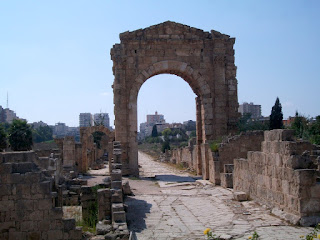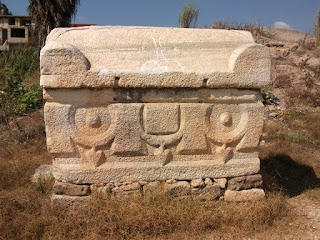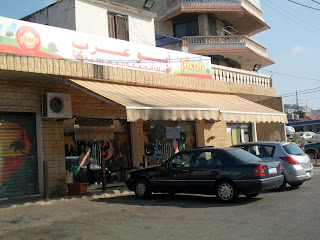 |
| A visit to the ancient Phoenician city of Tyre |
Some 88 kilometers (55 miles) from the capital Beirut, Tyre -- or Soor as it is known in Arabic -- is Lebanon’s fourth largest city. It was an island in ancient times and excavations there have uncovered ruins of Crusader, Arab, Byzantine and Greco-Roman cities.
 |
| Banana groves and the Mediterranean all along the journey |
The weekend highway drive from Beirut to South Lebanon is smooth until you hit Tyre, where the roads inland are in great disrepair.
I should have done more research before making the trip. My cousin Lillian and our friend Dunia Kabbani were excellent guides on the day. But I later discovered a wealth of brass tacks about the seaport city that has been battered so many times over the years. My findings came as I prepared to write this post and the captions for the photos of our day in Tyre.
 |
| Fish cafes line Tyre's free beach along the Corniche |
You cannot but feel humbled and irrelevant when standing by colonnades, arches, lodgings, baths, sarcophagus and mosaics that have survived millenniums. Walking around structures that have been standing for thousands of years, and will still be here long after we are gone, have a profound effect on the meaning and value of life or the lack of it. Are our iPads, Smartphones or skyscrapers likely to be around in 5,000 years? I wonder.
 |
| A national unity string of beads and... |
 |
| ...benches donated by Turkey on the Corniche |
But still… Leaving Orange House and driving towards Tyre, this time along the Mediterranean seaside road, we decided to visit one of the three archaeological sites before lunch.
There are three main areas of ruins in Tyre. The ruins of a Crusader church dominate the first site, but I didn’t venture there on this trip.
The second is located on what was the ancient walled island city. Colonnades, mosaic streets, Roman baths, and a rectangular arena occupy this site that overlooks the shimmering light blue Mediterranean. And this is where we walked around first.
 |
| The sculpted tip of one of the colonnades |
The sheer size of the colonnades is overwhelming, let alone the intricate sculpture at their tips. I strolled on awe-inspiring ground mosaics that continue to encapsulate the grandeur of the era in which they were created.
 |
| Tyre port |
We left this site and drove towards Tyre’s port. The original island city had two harbors -- one on its southern side and the other on its northern front. That helped Tyre gain the maritime prominence it did. Although the southern harbor has silted over, the northern one is still in use.
 |
| The narrow alleyways leading to the port |
We got there through narrow alleyways with old homes, some preserved and others not. We didn’t find a table in one of the portside restaurants. It was too hot to have some of South Lebanon’s delightful fish in one of the many cafés lining the free beach along the Corniche, so we headed to Tyre's Rest House.
 |
| The view from the Rest House restaurant |
 |
| Delicious South Lebanon fish |
We enjoyed a few glasses of Arak, fish, kebabs and a delicious hot potato salad before being served bitter Arabic coffee and watermelon.
 |
| Heading to the 2nd century Roman-Byzantine El Bass necropolis |
Satiated, we made our way to the third site and most extensive area of ruins on the mainland. It includes the 2nd century Roman-Byzantine El Bass necropolis on either side of a wide monumental way dominated by a triumphal arch and the largest Roman hippodrome ever found. It was uniquely built of stone, not brick. In its heydays, it could seat some 20,000 spectators eager to watch the chariot races.
 |
| The Colombarium |
 |
| The Triumphal Arch... a massive blow to any ego |
Here again, standing under the Triumphal Arch that leads to the Hippodrome, is a massive blow to any ego.
Tyre was known as “queen of the seas,” an island city of unprecedented splendor that Herodotus of Halicarnassus, "Father of History," visited during the 5th century BC and described the famous Temple of Melkart (Heracles). The priests of the city-god told him the temple was built 2300 years previously when Tyre was founded -- that is 2750 BC.
 |
| One of many sculpted sarcophagus |
The Greeks believed various aspects of their civilization had their origin in Tyre. Introduction of the alphabet into Greece was attributed to Cadmus of Tyre, and it was Europa, his sister, who gave her name to the continent.
Elissa, princess and daughter of king Mattan, extended Tyre's empire through the Mediterranean and founded Carthage in 814 BC. Early in the 6th century BC, Babylon king Nebuchadnezzar laid siege to the city for 13 years.
The origins of the famous purple dye in Tyre date back to a Phoenician legend involving Phoenician deities King Melqart and Queen Astarte. They were walking with their dog on the beach when the pet picked up something in its mouth that stained it crimson. Astarte thought it was beautiful and told Melqart that if he could make her a dress in that color, she would love him forever. So Melqart built the dye works.
Tyre is mentioned in the New Testament as one of the cities visited by Jesus Christ. Built by the Phoenicians, it was strong and an object of envies for many conquerors, particularly Alexander the Great.
 |
| Other parts of the necropolis |
The island city of Tyre was heavily fortified. It had a defensive wall about 46 m (150 ft) high surrounding it. Tyre was originally two distinct urban centers: Tyre itself, on an island just offshore, and the associated settlement of Ushu on the adjacent mainland. Alexander connected the island to the mainland by building a causeway during his siege of the city, demolishing the old part to reuse its cut stones and conquer Tyre in 332 BC.
The most famous city of Phoenicia was captured in 1124 during the First Crusade and became one of the most important cities of the Crusader Kingdom of Jerusalem. In 1291, the Mameluks retook Tyre. It then passed to Ottoman rule until it became part of the modern state of Lebanon after World War I.
The Old Testament makes several references to Tyre. It is prominently featured in Shakespeare’s play Pericles, Prince of Tyre. Oscar Wilde referred to the city and its purple dye in his poetry "...my Tyrian galley waits for thee, come down the purple sail is spread..." And the third verse of Bob Dylan’s 1966 Sad-Eyed Lady of the Lowlands begins: "The kings of Tyrus with their convict list / Are waiting in line for their geranium kiss.”
Unrest in South Lebanon, the illegal trade in antiquities and urban development continually threaten Tyre’s cultural heritage. Site degradation is also due to lack of maintenance and decay of porous and soft stones.
 |
| Archive photo of Tyre's First International Festival in 1972 |
In modern times, few people, if any, have done more than Mrs. Maha el-Khalil Chalabi, daughter of Lebanon's late political figure Kazem el-Kalil, to promote Tyre and protect its ruins and cultural heritage. She initially jolted Tyre out of its centuries of sleep by organizing the city's First International Festival back in July 1972.
 |
| Siniora and... |
 |
| Arabic sweets at Kanaan |
When it was time to head back to Beirut, we knew we first had to stop at Kanaan to stock on Siniora, the traditional South Lebanon sweet, and scoops of Arabic ice-cream – the best I’ve ever had. Because I couldn’t decide on the flavors, I just piled them all up. The best was a knafeh flavor that tasted exactly like the Arabic sweet itself.
 |
| You have to stop at Abu Arab for... |
 |
| ... freshly-baked ka'ak |
Another stopover was at Abu Arab to collect some freshly-baked ka’ak, the Lebanese street bread covered in sesame seeds and traditionally eaten with Picon processed cheese sprinkled with zaatar (thyme) and sumac. At less than $1 apiece, they are one of the most luscious, filling and budget foods. It was fun to watch how the shop assistant brought them straight from the wood oven and toss them into readied bags as you can see in the pictures.
There is so much more to write, but I’ll let you enjoy the parts left out in pictures.
Related posts:

